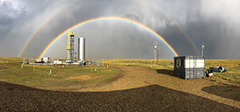2023 Project Achievement Award Recipient
Carbon Management Canada Newell County Facility

Carbon Management Canada’s Newell County Facility is giving Alberta a head start in the environmental research game. By studying and developing techniques and technologies to contain and store carbon dioxide underground, it’s helping us move towards a greener tomorrow.
When professional geophysicist Dr. Don Lawton identified that Alberta would be dependent on the fossil fuel-production industry for a long time to come, he knew we would need to lessen its environmental impacts. Setting out to prove that carbon capture and sequestration (CCS)—the trapping of carbon dioxide before it enters the atmosphere and storing it safely beneath the ground—is a safe and dependable process, Carbon Management Canada (CMC), in collaboration with the University of Calgary, launched the Newell County Facility in 2016.
Team members studied the effects of CCS on a smaller scale to ensure the technology was safe before it could be used commercially. In partnership with Cenovus Energy, they found a 200-hectare site near Brooks, Alta., with a suitable storage reservoir at a shallow depth of 300 metres. There, they injected carbon dioxide into the saline formation and are monitoring and measuring the injection formation, nearby ground surface, groundwater, and atmosphere to ensure the carbon dioxide is securely captured.
A remote early-warning system monitors for leaks, using seismic and electrical measurements to identify tiny amounts of carbon dioxide. “We’re able to demonstrate we can have good containment of carbon dioxide, even at these shallow depths. This is a technology that can be implemented with large volumes in a number of projects now being proposed in Alberta,” explains Dr. Lawton.
The facility also acts as a field laboratory, where companies verify new monitoring technologies before implementing them on a commercial scale, and a calibration site for methane emissions-testing equipment. It has the only dual-frequency comb spectrometer in Canada, which uses a laser to precisely measure methane and carbon dioxide concentrations up to a kilometre and a half away.
The team, consisting of CMC staff, University of Calgary graduate students and postdoctoral fellows, and researchers from other institutions, is now planning a move deeper underground to inject carbon dioxide at a depth more consistent with large, commercial-scale CCS projects. It will monitor changes using the same seismic, electrical, and electromagnetic measurement methods used at the current site. Ever evolving in the effort to reduce emissions, the facility continues to grow, and the team is sharing its learnings with fellow researchers in the hope others will take up the challenges of reducing greenhouse gas emissions into the atmosphere and fighting climate change.
As leaders in the industry, the team is affecting change on a rapid scale. “That’s the satisfaction: being able to implement a technology that is critical to the future of our planet.”
Key contributors to the project include, in alphabetical order:
- Dr. Hamid Behmanesh
- Dr. Joanna Cooper
- Dr. Kris Innanen
- Brendan Kolkman-Quinn, G.I.T.
- Dr. Don Lawton, P.Geoph., FGC, FEC (Hon.)
- Dr. Marie Macquet
- Greg Maidment, P.Geo.
- Dr. Bernhard Mayer
- Kirk Osadetz
- Franki Race
